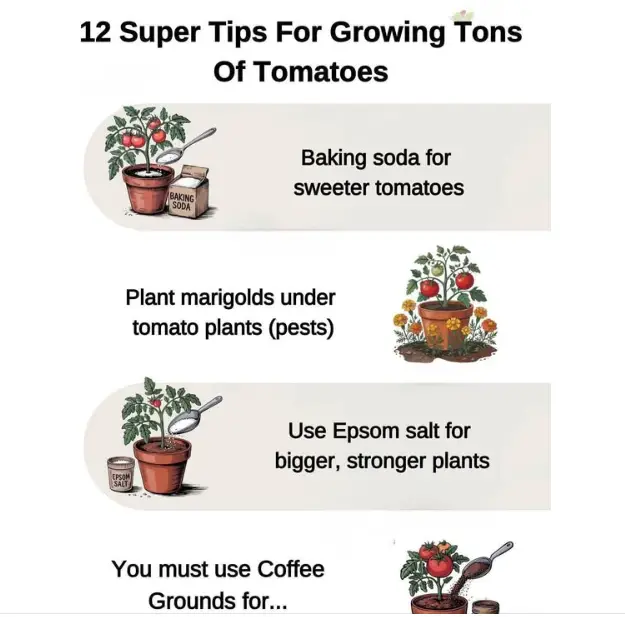Easy Growing Tips!
Are you aiming to increase fruit yield in your tomato crop but feeling unsure about where to begin? You’re not alone. Many gardeners struggle to turn healthy tomato plants into bountiful harvests. But with the right knowledge and precise techniques, it’s absolutely achievable. Below, we present 12 powerful tomato-growing tips that will maximize your harvest and help you grow vibrant, juicy tomatoes like a seasoned pro.
1. Bury Tomato Stems Deep for Stronger Roots
Tomato plants are unique in their ability to grow roots all along their stems. By burying the stem deeper into the soil, you stimulate the development of a larger and stronger root system, which anchors the plant and improves water and nutrient uptake. When transplanting, remove the bottom leaves and bury two-thirds of the stem into the ground.
2. Proper Tomato Plant Spacing Is Critical
Overcrowding tomato plants can restrict airflow and promote fungal diseases like blight. Space your tomato plants at least 18 to 24 inches apart to ensure adequate air circulation. For indeterminate varieties that grow tall and wide, allow 3 to 4 feet between rows for optimal growth and ease of access during harvesting.
3. Mulch for Moisture Retention and Temperature Control
Applying a thick layer of organic mulch—such as straw, shredded leaves, or compost—around the base of each plant helps retain moisture, regulate soil temperature, and reduce weed competition. Mulching also prevents soil from splashing onto the leaves, reducing the chance of soil-borne diseases.
4. Remove Lower Leaves to Prevent Disease
Tomato leaves that come into contact with wet soil are prone to rot and disease. Remove the lower 6–10 inches of leaves as the plant grows to prevent moisture-related issues. This not only promotes better airflow but also allows sunlight to reach the lower stems, keeping the entire plant healthier.
5. Pinch Off Suckers for Focused Fruit Production
Tomato plants often develop small shoots known as “suckers” between the main stem and branches. These divert energy away from fruit production. By pinching off these suckers early, you help the plant focus its energy on growing larger, more flavorful tomatoes.
6. Stake or Cage Your Tomatoes to Keep Them Off the Ground
Tomatoes that grow along the ground are more likely to rot or be attacked by pests. Use stakes, cages, or trellises to keep plants upright and support heavy fruit. For indeterminate varieties, tall cages or sturdy vertical stakes with regular tying are essential to manage vertical growth.
7. Use Copper Strips to Deter Slugs and Snails
Slugs and snails can devastate young tomato plants. Surrounding your plants with copper strips forms a natural barrier. When these pests come into contact with copper, they experience an unpleasant reaction that prevents them from crossing, thus protecting your plants without chemicals.
8. Water Consistently for Optimal Growth
Tomatoes thrive on consistent moisture. Inconsistent watering can lead to blossom end rot and fruit splitting. Stick to a regular schedule, watering deeply 2–3 times per week rather than shallow, frequent watering. Adjust based on rainfall and soil moisture.
9. Avoid Wetting Tomato Leaves
When watering, always aim at the base of the plant, not the foliage. Wet leaves can harbor fungal spores and promote diseases like early blight or powdery mildew. A soaker hose or drip irrigation system is ideal for keeping leaves dry while delivering consistent moisture directly to the roots.
10. Boost Growth with Epsom Salt
Epsom salt is rich in magnesium sulfate, a vital nutrient for tomato plants. Mix 1 tablespoon of Epsom salt per gallon of water and apply this mixture once every two weeks. It promotes chlorophyll production, reduces leaf yellowing, and enhances fruit development.
11. Use Companion Planting to Naturally Repel Pests
Marigolds are an excellent companion plant for tomatoes. They deter aphids, nematodes, and whiteflies, acting as a natural insect repellent. Other good companions include basil, which improves flavor and repels hornworms, and borage, which attracts pollinators and deters tomato worms.
12. Fertilize Strategically for Maximum Yield
Tomatoes are heavy feeders and require a balanced nutrient supply. Use a slow-release fertilizer or composted manure early in the season, and supplement with a low-nitrogen, high-phosphorus fertilizer during flowering and fruiting stages. Avoid over-fertilizing with nitrogen, as it will encourage leafy growth over fruit development.
Final Thoughts: The Key to Tomato Growing Success
Mastering the art of tomato growing comes down to a combination of preparation, maintenance, and consistency. From deep planting and proper spacing to smart watering and strategic pruning, every step builds toward a healthier plant and a bigger harvest. Implement these 12 tips in your garden and you’ll soon enjoy an abundance of ripe, delicious tomatoes season after season.

